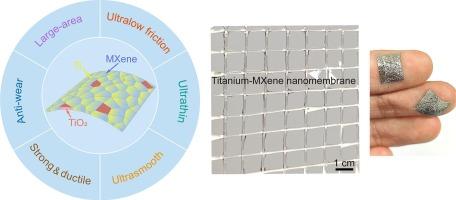原位成形钛- mxene纳米膜作为超薄范德华润滑剂
IF 22
1区 材料科学
Q1 MATERIALS SCIENCE, MULTIDISCIPLINARY
引用次数: 0
摘要
高性能固体润滑剂是在高温和高负荷条件下抑制摩擦能耗和磨损相关排放的关键。然而,在纳米尺度的摩擦接触下,层状二维材料可能会在极端环境中失去其不相称的范德华(vdW)界面排列,导致摩擦退化。在这里,我们报告了大面积、高性价比的Ti-MXene杂化纳米膜(<;50 nm厚)的可扩展制造,由原位化学键合金属Ti和Ti3C2Tx MXene纳米晶体组成。我们的纳米膜在高接触压力下从室温到573 K的温度范围内表现出出色的各向同性摩擦学性能。它们表现出接近零磨损,磨损率低于10-9 mm3/Nm,超低摩擦系数低于0.01,即使在接触压力超过10 GPa和原子力显微镜压痕下的高温(473-573 K)下也能实现中尺度超润滑。这些卓越的性能源于我们纳米膜独特的纳米结构、卓越的强度和高延展性,以及磨损过程中MXene分解引发的原位纳米氧化和碳迁移。原位实验和多尺度模拟结果表明,将MXene限制在Ti纳米晶体中不仅可以提高自润滑性能,还可以通过降低摩擦化学保护的能垒来提高耐磨性。此外,这些纳米膜作为超薄vdw固体润滑剂,有效地减少了各种技术上重要的工程材料,如钛合金、不锈钢和聚四氟乙烯(PTFE)的摩擦和磨损。本文章由计算机程序翻译,如有差异,请以英文原文为准。

In-Situ formed Titanium-MXene nanomembrane as ultrathin van-der-Waals lubricant
High-performance solid lubricants are pivotal in curbing frictional energy consumption and wear-related emissions under high-temperature and high-load conditions. However, under nanoscale tribological contacts, layered two-dimensional materials may lose their incommensurate van der Waals (vdW) interfacial alignment in extreme environments, leading to frictional degradation. Here, we report the scalable fabrication of large-area, cost-effective Ti-MXene hybrid nanomembranes (<50 nm thick), composed of in-situ chemically bonded metallic Ti and Ti3C2Tx MXene nanocrystals. Our nanomembranes exhibit outstanding isotropic tribological properties within a temperature range spanning from room-temperature to 573 K under high contact pressures. They demonstrate near-zero wear with a wear rate below 10-9 mm3/Nm, and an ultra-low coefficient of friction below 0.01, achieving mesoscale superlubricity even at contact pressures exceeding 10 GPa and elevated temperatures (473–573 K) under atomic force microscopy indentation. These remarkable properties stem from the unique nanostructure, exceptional strength and high ductility of our nanomembranes, along with an in-situ nano-oxidation and carbon migration initiated by MXene decomposition during wear. In-situ experiments and multiscale simulations reveal that the confinement of MXene within the Ti nanocrystals not only imparts self-lubricating behavior but also enhances wear resistance by lowering the energy barrier of the tribochemical protection. Furthermore, these nanomembranes function as ultrathin vdW-enabled solid lubricants, effectively reducing friction and wear on various technologically important engineering materials, such as titanium alloy, stainless steel, and polytetrafluoroethylene (PTFE).
求助全文
通过发布文献求助,成功后即可免费获取论文全文。
去求助
来源期刊

Materials Today
工程技术-材料科学:综合
CiteScore
36.30
自引率
1.20%
发文量
237
审稿时长
23 days
期刊介绍:
Materials Today is the leading journal in the Materials Today family, focusing on the latest and most impactful work in the materials science community. With a reputation for excellence in news and reviews, the journal has now expanded its coverage to include original research and aims to be at the forefront of the field.
We welcome comprehensive articles, short communications, and review articles from established leaders in the rapidly evolving fields of materials science and related disciplines. We strive to provide authors with rigorous peer review, fast publication, and maximum exposure for their work. While we only accept the most significant manuscripts, our speedy evaluation process ensures that there are no unnecessary publication delays.
 求助内容:
求助内容: 应助结果提醒方式:
应助结果提醒方式:


